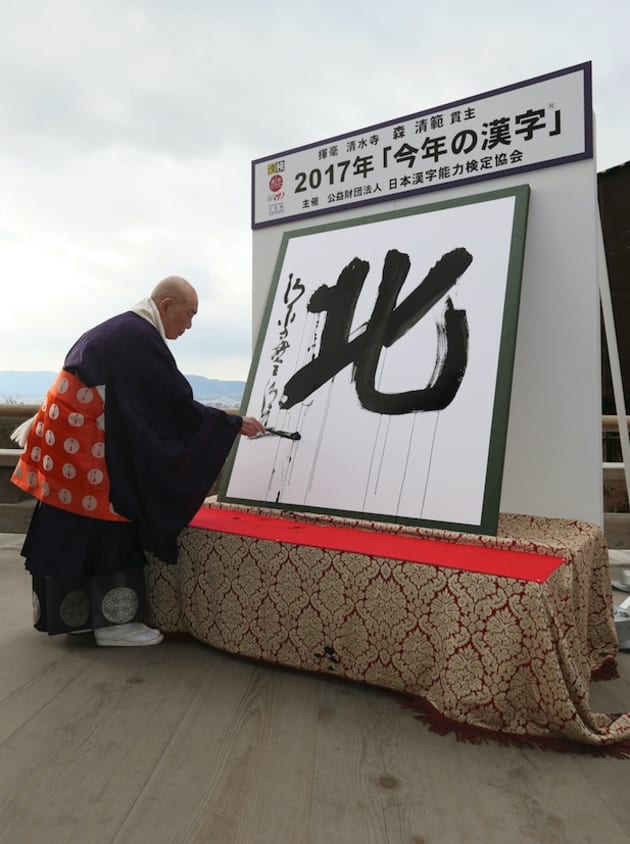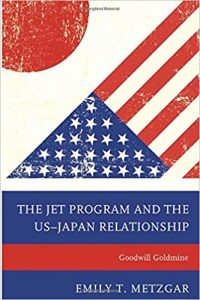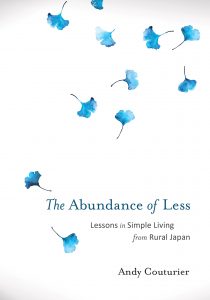JQ Magazine: Book Review — ‘Zen Gardens and Temples of Kyoto’
By Rashaad Jorden (Yamagata–ken, 2008-10) for JQ magazine. A former head of the JETAA Philadelphia Sub–Chapter, Rashaad is a graduate of Leeds Beckett University with a master’s degree in responsible tourism management. For more on his life abroad and enthusiasm for taiko drumming, visit his blog at www.gettingpounded.wordpress.com.
Kyoto has served as the focal point of Japanese cultural forms such as geisha, noh theater and ikebana. And as John Dougill thoroughly details in Zen Gardens and Temples of Kyoto, the city has played an enormous role in the development of Zen in Japan.
A professor at Kyoto’s largest Buddhist university, Dougill explores the ties between Japan’s former capital and the Buddhist sect in this guide to Kyoto’s most prominent Zen gardens and temple sites. While not the birthplace of Zen in Japan, Kyoto could be considered its soul as the city has long housed renowned temples where visitors and monks have sought serenity.
At first glance, such a book would seem to be a largely visual journal featuring a score of beautiful places. Zen Gardens doesn’t disappoint in that regard as photographer John Einarsen captures the splendor of some very spiritual places. But it’s clear early on that the book will rely primarily on stories to chronicle the story of Zen in Kyoto—not surprising since Dougill has previously written about Japan’s World Heritage Sites and Kyoto’s history.
WIT Life #319: 今年の漢字
Written by professional Writer/Interpreter/Translator Stacy Smith (Kumamoto-ken CIR, 2000-03), WIT Life is a periodic series about aspects of Japanese culture such as film, food and language. Stacy starts her day by watching Fujisankei’s newscast in Japanese, and here she shares some interesting tidbits and trends along with her own observations.

As we approach the end of 2017, many of us are reflecting on what was a less-than-stellar year. This was also an anxiety-producing year in Japan, as the designation of this year’s kanji as 北 (kita or north) indicates. It came in with 7104 votes out of the total 153,594 cast, and best captures the mood in Japan amid the heightened nuclear and missile threat posed by North Korea. North Korea has continued to pursue its nuclear weapons and missile programs despite tough new sanctions, including conducting a sixth nuclear test and launching two missiles over 北海道 (Hokkaido) in late summer.
In regard to the selection of 北, other Hokkaido connections were also referenced by respondents. The island’s poor potato crop this year led to nationwide shortages of potato chips, and there is much excitement for 二刀流 (nitouryuu or combination pitcher/slugger) Shohei Otani of Hokkaido baseball team Nippon Ham Fighters making his major league debut with the Anaheim Angels next year.
Coming in second place with 3,571 votes was 政 (sei/matsurigoto or politics). Political scandals, as well as Read More
JQ Magazine: Jamming After JET — Rural Island Alums Release New Albums

“Living in Japan exposes you to music you would not have heard otherwise. I owe most of my knowledge to availability of 100 yen records all over the country and the friendly record store employees that were eager to teach me about Japanese music.” (Courtesy of Eli Cohen)
By Greg Beck (Hiroshima–ken, 2006-11) for JQ magazine. Greg is a writer, producer, home brewer, and Social Coordinator for JETAA Southern California and Arizona. A former news producer for Tokyo Broadcasting System in New York, he currently works freelance in Los Angeles. For more cinema reviews, follow him on Twitter at @CIRBECK #MovieReview.
Regardless of your placement on JET, music is a constant part of the experience. Whether it is karaoke parties with friends, music festivals like Fuji Rock, “live house” local performances, or simply singing Beatles and Carpenters with your students (over and over), all of us take something musical with us from our time on JET. But what about musicians who join JET? JQ reached out to two alumni from small islands off the coast of Kyushu, who have gone on to release their own albums, and hear from them how these unique records reflect that experience.
Eli Cohen (Kagoshima-ken, 2009-2010) runs the International Admissions department at one of the City University of New York’s institutions. He is also a DJ who started a record label, Alliance Upholstery. His new album, Tokyo Nights: Female J-Pop Boogie Funk —1981 to 1988, is a collection of music that fits into this genre.
If that sounds obscure, we thought so, too. Cohen explains: “In high school I was really into Japanese punk (Teengenerate, Guitar Wolf). This is where my interest in Japan started. As I grew older, I became very interested in Japanese music from the ’80s, as well as fashion and art from the era. Japanese people refer to this style as ‘City Pop.’ Outside of Japan, the term is a little vague and people often call this Japanese Boogie. The sound reflects the attitude and excitement of the bubble, bright and full of optimism,” adding that his favorite artist is Toshiki Kadomatsu.
Many JETs can probably relate to Cohen’s experience as a JET placed on a rural, island, both in the difficulties adjusting, and the unexpected opportunities. Having spent several years before JET living in Osaka and Tokyo, Cohen was placed in Minamitane, below the southernmost tip of Kyushu, which he describes as “a tiny town of about 8,000 people on the island of Tanegashima.” Before that, he says, “I had felt very little culture shock when I first moved to Japan as I had only lived in major cities. Tanegashima was my first taste of inaka life and a very unique and challenging experience.” While he admits, “The students were great but I prefer city life and was eager to return to Tokyo,” he also shared the following: “JAXA, the Japanese space program, is based in Minamitane. There was a bar in town appropriately titled Moon Bar. I would DJ there on occasion and tried to incorporate space themes into the sets.”
JQ Magazine: Book Review — ‘The JET Program and the US-Japan Relationship: Goodwill Goldmine’

“While focused solely on the American experience, the outline of the history and intention behind the JET Program’s creation is a fascinating and illuminating one. One hopes that this book will be the start of the conversation and academic study on JET’s other accomplishments and help complete the picture of a fallible but venerable institution.” (Lexington Books)
By Eden Law (Fukushima-ken, 2010-11) for JQ magazine. Eden is the current JETAA New South Wales President (in Sydney, Australia) and Australian JET Alumni Association Country Representative, and handles the social media/website side for JETAA International as Webmaster. He also runs the Life After JET podcast.
Note: Spelling is always problematic when dealing with international differences. I shall be spelling “Program” the way it is referred to in the book and the title, to avoid inconsistencies. Apologies, especially to any fellow Australians reading this. However, I’ll be keeping my quixotically placed “u”s and “r”s.
Created in 1987, The JET Program has brought tens of thousands of young people from around the world to work, live and experience life in Japan. An international exchange program of a diplomatic nature, its aims were to improve global perceptions towards Japan and to internationalised Japanese local communities, all through the format of teaching and improving English skills in schools. Since then, articles and papers about the effectiveness of JET has focused primarily on its impact (or lack thereof) on the level of English language ability on the student population, leading to questions about the feasibility of maintaining the high costs of the program. At least once, the program came close to termination: In 2010, a Japanese government budget review panel called for the discontinuation of JET, before the subsequent administration of Shinzo Abe saved it, setting the agenda for expanding numbers in the lead-up to the 2019 Rugby World Cup and the 2020 Tokyo Olympics.
More positive literature exists, of course: David L. McConnell’s Importing Diversity: Inside Japan’s JET Program, published in 2000, is the most well-known example, written by an academic who was once a JET participant. Seventeen years on, Emily T. Metzgar (Shimane–ken, 1993-95), herself also once a JET and now an academic, has penned a follow-up of sorts, entitled The JET Program and the US-Japan Relationship: Goodwill Goldmine, which, as described in its title, confines its evaluation of the program on its international impact in relation to the United States and Japan. The JET Program justifies its restricted focus on this bilateral relationship on its assertion that the program was originally created with the United States in mind as the first target for Japan to improve its international image abroad. Statistically, 50 percent of the total number of participants throughout the program’s history have been sourced from the United States (and in an impeccable sense of timing, the book arrived on the eve of the program’s big 30th anniversary celebrations and JETAA conference in Washington, D.C., featuring Metzgar as one of the headline presenters).
Commentators seeking to put a more positive outlook on the program’s accomplishments have had to look outside of the hoary old topic of education. The JET Program settles on examining how it worked as a “soft power” initiative for Japan’s global image (the topic of how JET fared as an internationalisation agent of Japanese local community is, as Metzgar says, best left “as a promising research topic for an ambitious doctoral student,” though she does comment on these other aims later on). For those wondering, yes, the book argues that JET has been enormously successful in this aspect. Examples are plentiful in The JET Program: recalling the threat of JET’s culling high-profile American JET alumni in organisations such as the American Enterprise Institute (AEI) and JCIE/USA defended it by referring to its “soft power” success. In other less fraught periods, the book cites senior members and policymakers of both governments who spoke positively of JET’s contributions to their countries’ relationship, implying acknowledgement of the same thing.
Job: Assistant Director – University of San Francisco (San Francisco, CA, USA)
Posted by Sydney Sparrow. Click here to join the JETwit Jobs Google Group and receive job listings even sooner by email.
Position: Assistant Director, Center for Asia Pacific Studies,
Posted by: University of San Francisco
Location: San Francisco, CA, USA
Contract: Full-Time
Thanks to JETAA USA country rep, Mark Frey for passing along the following job opening:
We’re hiring! All applications must be submitted through the USF jobs portal: https://www.usfjobs.com/postings/13428
Job: Multiple Positions – Morikami Museum (Delray Beach, FL, USA)
Posted by Sydney Sparrow. Click here to join the JETwit Jobs Google Group and receive job listings even sooner by email.
Position: Digital Marketing Coordinator, Audio Visual Technician, or Exhibition Design Technician
Posted by: Morikami Museum
Location: Delray Beach, FL, USA
Contract: Full-Time
Thanks to JETAA Florida’s Wendy Lo, who works for the Morikami Museum, for sharing these JET-relevant openings.
The positions at the Morikami Museum and Japanese Gardens include:
- Digital Marketing Coordinator
- Audio Visual Technician
- Exhibition Design Technician
Job descriptions and details on how to apply can be found here: https://morikami.org/job-opportunities/
Job: Higher Education Associate – CUNY (New York City, NY, USA)
Posted by Sydney Sparrow. Click here to join the JETwit Jobs Google Group and receive job listings even sooner by email.
Position: Travel Consultant
Posted by: The Art of Travel
Location: CUNY
Contract: Full-Time
Thanks to JET alum Joseph Lavetsky, who works on student immigration issues for CUNY, for passing along this JET-relevant opportunity.
https://www.jjay.cuny.edu/employment-opportunities
John Jay has established a new Center focused on serving the needs of their immigrant, undocumented, and DACA students. Therefore, an Immigrant Student Success Manager is needed at both, John Jay and within CUNY. The new opening was just posted and will close on January 10, 2018. Please see below for more details.
POSITION OVERVIEW
John Jay is proud to be establishing a new on-campus New America Student Support Center that will employ a variety of strategies to provide academic, career, scholarship and social support for students who may be undocumented, immigrants (including students with Deferred Action for Childhood Arrivals (DACA), Temporary Protected Status (TPS), work permits, or refugee status, or who possesses other visas unrelated to international study), or coming from mixed immigration status families. In a newly created role at John Jay and within the CUNY system, the Immigrant Student Success Manager will lead the Center and conceive and implement programming to assist these students in overcoming the unique academic, career, personal, and professional challenges they may encounter as college students. Read More
Job: Travel Consultant – The Art of Travel (Tokyo or Kanazawa, Japan)
Posted by Sydney Sparrow. Click here to join the JETwit Jobs Google Group and receive job listings even sooner by email.
Position: Travel Consultant
Posted by: The Art of Travel
Location: Tokyo or Kanazawa, Japan
Contract: Full-Time
Thanks to JET alum Erin Kessler (Gunma-ken) for the following job opening:
ABOUT THE ART OF TRAVEL
The Art of Travel calls Japan home and between us we have decades of combined experience living, working and raising our families here in Japan. The AOT team is comprised of artists, writers, and travel professionals, all passionate about Japan and authorities on the culture. Our extensive network reaches throughout the country and includes everyone from artisans to architects and geisha to gardeners.
We invite you to join our team of Japan enthusiasts and help us to show the world all this wonderful country has to offer.
GENERAL JOB DESCRIPTION
This position entails a variety of responsibilities, including planning & overseeing itineraries for overseas clients, coordinating work between the Tokyo, Kanazawa and New York offices, meeting clients and assisting with various portions of trips, and participating in research and development of new products.
Your typical day will involve answering emails from clients, crafting custom itineraries, coordinating itinerary contents with reservation staff and occasionally attending client meet and greets.
As a travel consultant, you will need to utilize your strong communication skills and professionalism through daily interactions with clients and vendors.
Job: Multiple Positions – Actus Consulting Group (USA)
Posted by Sydney Sparrow. Click here to join the JETwit Jobs Google Group and receive job listings even sooner by email.
Position: Multiple Positions
Posted by: Actus Consulting Group
Location: Multiple Locations (USA)
Contract: Full-Time
Thanks to Makiko Takeda and Actus Consulting Group for the following job openings:
With our nation-wide network, Actus Consulting Group, Inc provides professional support to job seekers who are interested in working for Japanese companies located in USA. If you are seeking a job, we are more than happy to support you from your job search and guide you all the way to your first day at a new job!
Please feel free to browse newest jobs available from the link below, and apply with one-click, or email Info@actus-usa.com with your resume as an attachment to register for free!
http://www.actus-usa.com/index/En
HOT JOB OF THE MONTH!
- Beauty products distributor seeks a Sales representative- NYC
- Salary: $35K
- Fluency in English and Japanese conversational or higher
- Japanese advertising agency seeks a Business Development specialist-NYC
- Salary: $60K~ (DOE)
- Proven strong organizational skills and great communication skills
- Japanese and English Bilingual (Business-level)
- Japanese Top Beverage maker seeks a Route Sales Representative-NYC
- Salary: $35K+
- Fluency in English
- Japanese language a plus
- Japanese machine tool company seeks a Customer Service- Elk Grove Village, IL
- Salary: $30-35K
- Fluency in English
- Japanese language a plus
- Japanese steel company seeks an Outside Sales- Schaumburg, IL
- Salary: $40K- DOE
- Fluency in English
- Japanese language a plus
We have more positions throughout USA in various industries- please contact us!
A-DOC: Arabic Classes in New York City
These articles are recurring features written by Friend Of JET, Jon Hills, who maintains the blog for Hills Learning (www.hillslearning.com). Hills Learning is a NY-based language learning center that offers group and private Japanese, Korean, Chinese, Thai, Arabic, Cantonese and Spanish classes.
Arabic Class listing can be found at: Arabic Classes NYC and Arabic Classes Online
So you might be interested in learning Arabic? In New York City, there’s a variety of Arabic classes offered from a variety of institutions. What this article does is discuss learning Arabic from the lense of a Japanese language learner (assuming most readers on JETWIT have either learned or attempted to learn Japanese in the past).
First of all, why learn Arabic? Just turn on the news and you’ll find out that a lot of the political, business and cultural trends these days seem to be coming from the Middle East. And Arabic (now keep in mind, there are multiple dialects), is the predominate language across the region.
Now to approach Arabic from a Japanese perspective. First of all, Japanese has only five vowel sounds (AIUEO), in case you remember that’s pretty small right? Wrong! Imagine a language with only three vowel sounds, that is Arabic. It sounds crazy but true, what you’ll end up finding is that a lot of words don’t have any vowel at all.
So next up is the alphabet, after all most diligent Japanese learners started by writing out their alphabets for Hiragana and Katakana, right? Do you remember how many characters per language that was? 46. So, you had to learn about 92 characters to start out to begin to pronounce and write Japanese. Arabic only has 28, so you can imagine how quickly your learning might go if you dive into this language.
I know the theme of this article is about how easy Arabic is, believe me, it’s a category IV difficult language (according to the DLI rankings) for a reason (Japanese is too, by the way). (FYI Category IV is the most challenging for English speakers) The fine print that I won’t really emphasize is that each letter’s shape changes depending on where it ends up in the word. Also the pronunciation of Arabic, unlike Japanese, has many sounds that are unfamiliar to the typical English speaker.
The most important thing I’ll end with is that surprisingly enough, when you develop your ability to speak one language, it actually enables you to speak another language easier. I think the confidence that you develop when you find a voice in a second language adds to your confidence to continue to build on this with a third language. I wish all of you the best of luck in your language pursuits! Please feel free to ask any questions.
JQ Magazine: Film Review — ‘In This Corner of the World’

“In This Corner of the World is more than a good story with vibrant animation. It is a thoughtful work of art that holds its own against the other big anime hit of 2016, Your Name.” © Fumiyo Kouno/Futabasha/Konosekai no Katasumini Project
By Preston Hatfield (Yamanashi–ken, 2009-10) for JQ magazine. Preston is the English teacher you wish you had growing up. He taught in Kofu, Yamanashi on JET and later received his Master’s in Education and teaching credential from Stanford University. He now teaches English at a public high school in the Silicon Valley, and is inspiring the leaders of tomorrow one dank meme at a time.
Raise your hand if you remember how it felt to watch Grave of the Fireflies. It isn’t often that you’re truly glad to have watched a film that slowly rips your heart out, but the iconic 1988 film about Japan during World War II did exactly that for generations of viewers. Nearly 30 years later, director Sunao Katabuchi (Mai Mai Miracle) has created his own anime masterpiece that is every bit as poignant, tragic and beautiful as Grave of the Fireflies.
Based on the award-winning manga by Fumiyo Kouno, In This Corner of the World follows Suzu, an 18-year-old girl from Hiroshima, as she is plucked from her life by a man she only vaguely knows and moves in with his family in the nearby naval port city of Kure. As Suzu acclimates to life with her new family, the audience gets a look at the daily ins and outs of domestic life for Japanese women at the time, from tending the garden and collecting locally grown plants to make their meals, to refashioning kimonos into trousers and robes. Suzu also struggles with learning how to be a good wife and ingratiating herself to her new in-laws and her husband’s hypercritical sister.
In the latter half of the film, Katabuchi shows how the war progressively deteriorates the Japanese’s sense of normalcy, comfort, and security. What was once a quaint seaside naval town is reduced to a scene of waking nightmare and blazing fire. There are incessant air raid sirens and evacuations to bomb shelters, government propaganda, espionage hysteria, overcrowded hospitals, and the incomprehensible annihilation of cities and the people who populate them. But despite a number of somber (if not heart-wrenching) moments, In This Corner of the World ends the way most of us wish Grave of the Fireflies could have ended, and that small dose of optimism makes the film much easier to sit with when the credits roll.
Job: Summer Program Leader – World Learning (Vermont and Japan)
Posted by Sydney Sparrow. Click here to join the JETwit Jobs Google Group and receive job listings even sooner by email.
Position: Summer Program Leader
Posted by: World Learning
Location: Vermont and Japan
Contract: Full-Time
Here’s an opportunity received directly from the organization:
The Experiment in International Living is currently hiring exceptional professional individuals to serve as Group Leaders to guide our summer 2018 programs in Japan!
About Us
The Experiment, the founding program of World Learning, has been sending students on immersive abroad programs since 1932, and we continue to be on the cutting edge of international education. Our programs provide high school students with the opportunity to connect deeply and engage meaningfully with the richness and complexities of another country through hands-on experiences in local communities and through the lens of a specific program theme.
Each program has two adult co-leaders who work together to guide a group of 10 to 15 high school students on a 4-week journey. Our Leaders are our most critical on-the-ground resource, traveling alongside the group and serving as the students’ primary support throughout the program. Leaders take on a wide range of responsibilities, including helping students integrate into local cultures and host families, conducting group excursions, and guiding students through discussions of and reflections on their experiences. Leaders work closely with The Experiment’s US-based staff and in-country partners to maximize students’ health and safety and to ensure the program is meaningful, challenging, and experientially rich.
Ongoing Support from Program Start to Finish
Experimenters are met by their two group leaders at a specific meeting location in the designated departure airport in the US. Group leaders immediately start engaging students in conversations and ice-breaker activities. Right away – and continuing throughout the in-country orientation – leaders work with Experimenters to increase their knowledge of the host country and culture, develop communication skills, and cultivate new attitudes and awareness. During the course of the program, leaders keep in close contact with homestay families, conduct group excursions, and guide students through discussions of and reflections on their experiences. At the end of the program, leaders help students synthesize their experiences and assist them in considering how they can integrate what they learned about themselves and the world into their lives moving forward.
Commitment to Diversity
The Experiment is committed to recruiting and supporting students of diverse backgrounds, and thus The Experiment is equally committed to hiring Group Leaders who represent diverse geographic, ethnic, religious, and economic backgrounds. Read More
JQ Magazine: Book Review — ‘The Abundance of Less’

“Although the purpose of The Abundance of Less might be to extol the virtues of simple living, it emerges as an enriching journey into the world of many extraordinary people.” (North Atlantic Books)
By Rashaad Jorden (Yamagata–ken, 2008-10) for JQ magazine. A former head of the JETAA Philadelphia Sub–Chapter, Rashaad is a graduate of Leeds Beckett University with a master’s degree in responsible tourism management. For more on his life abroad and enthusiasm for taiko drumming, visit his blog at www.gettingpounded.wordpress.com.
Simple living. Sustainability. Living off the grid. Practices and ideals that could bring about an enriching life and possibly freedom for many people—as well as concepts that have become more prevalent in recent years.
But the above-mentioned buzzwords aren’t endemic to the West. Thanks to Andy Couturier, the stories of Japanese living the most sustainable lives they can outside of the mainstream is documented in The Abundance of Less: Lessons in Simple Living from Rural Japan.
Couturier, a former English teacher and staff writer for the Japan Times, originally profiled ten Japanese living “a very principled way of life” that didn’t feed the capitalist machine for his 2010 book A Different Kind of Luxury. Spurred on by a surge in environmental activism following the nuclear meltdown in Fukushima, the author provides updates on each of the people he profiled in his original book (unfortunately, two of them have since passed away).
The people providing the “lessons” are (or have been), among other things, an anarchist; a writer/filmmaker inspired by the hippie counterculture; and a painter. Couturier was introduced to several of the ten people he wrote about by Atsuko and Gufu Watanabe, a couple he and his partner Cynthia met while teaching in Japan. Although the bookends of The Abundance of Less are dominated by his observations about life in Japan, a how-to guide for those wanting to follow in his footsteps (Couturier and his partner built their abode in California by themselves and applied many of the principles they learned in Japan) and his life story, the book largely focuses on the remarkable individuals he profiles.
JET Prefecture Round up 12.16.17
JET Prefecture Round Up is a weekly mosaic of events taking place in the AJET community in Japan. Compiled by Suzanne Bhagan, (Tottori Prefecture).
Global Cafe: A Christmas Special
When: 17 December
Where: Kyoto Prefecture
Kameoka International Exchange Association is hosting a Christmas party this Sunday. It’s free for foreigners and includes snacks, games, presents, and a little craft workshop.
When: 25 December
Where: Shiga Prefecture
For those of you who’re staying in Japan for Christmas, you’re invited along to a Christmas day get together and potluck dinner.
When: 29 December
Where: Ishi-gun, Shimane Prefecture
Kadomatsu are traditional Japanese New Year decorations. Come visit Iinan and learn how to make your own, using real bamboo and decorations.
Job: International Policy Analyst – Mitsubishi UFJ Financial Group (Washington D.C., USA)
Posted by Sydney Sparrow. Click here to join the JETwit Jobs Google Group and receive job listings even sooner by email.
Position: International Student Engagement Specialist
Posted by: Mitsubishi UFJ Financial Group
Location: Washington D.C., USA
Contract: Full-Time
Thanks to JET alum Jordan Heiber (Fukui-ken) for the following job opening with his company:
We are proud to be an Equal Opportunity/Affirmative Action Employer and committed to leveraging the diverse backgrounds, perspectives and experience of our workforce to create opportunities for our colleagues and our business. We do not discriminate in employment decisions on the basis of any protected category.
https://uboc.taleo.net/careersection/10090/jobdetail.ftl?job=10018250-wd
MUFG: International Policy Analyst (Washington, DC)
Description
Discover your opportunity with Mitsubishi UFJ Financial Group (MUFG), the 5th largest financial group in the world with total assets of over $2.4 trillion (as ranked by SNL Financial, April 2016) and 140,000 colleagues in nearly 50 countries. In the U.S., we’re 13,000 strong, working together to positively impact every customer, organization, and community we serve. We achieve this by delivering on our values, putting people first, fostering long-term relationships built on honesty and mutual understanding, and inspiring the best in each other. This is all part of our inclusive, high-performing culture supported by Total Rewards that include our cash balance pension plan. Join a team that’s working to fulfill its vision to be the world’s most trusted financial group.




